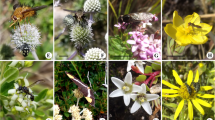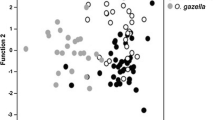Abstract
Visitations of flowers of the Crown Imperial by Great Tits at two different locations in Hessen, Germany, in 1990 and 1993 are described. The observations prove that flowers were visited because of the nectar; most likely pollination occurs during this visits. Similar reports from Europe are discussed. The significance of specific interactions including ecological generalists such as the Great Tit is considered in the context of the phylogenetic reconstruction of the development of co-adaptive syndroms.
Zusammenfassung
Beobachtungen von Kohlmeisen (Parus major) an Blütenständen der Kaiserkrone (Fritillaria imperialis) in Hessen zeigen, daß der Blütenbesuch des Nektars wegen erfolgte und daß dadurch mit größter Wahrscheinlichkeit eine Bestäubung der Pflanzen erreicht wird. Ähnliche Fälle aus Europa werden diskutiert. Die Bedeutung spezifischer Interaktionen unter Beteiligung ökologischer Generalisten wie der Kohlmeise für die Rekonstruktion der phylogenetischen Entstehung co-adaptiver Syndrome wird erörtert.
Similar content being viewed by others
Literature
Ash, J. S., P. H. Jones &R. Melville (1961): The contamination of birds with pollen and other substances. Brit. Birds 54: 93–100.
Brooks-King, M., &H. G. Hurrell (1958): Intelligence tests with Tits. Brit. Birds 51: 514–524.
Burquez, A. (1989): Blue Tits,Parus caeruleus, as pollinators of the Crown Imperial,Fritillaria imperialis, in Britain. Oikos 55: 335–340.
Campbell, W. D. (1963): Warblers as pollinators in Britain. Brit. Birds 56: 111–112.
Cortes, J. E. (1982): Nectar feeding by European passerines on introduced tropical flowers at Gibraltar. Alectoris 4: 26–29.
Ebbels, D. L. (1969): Pollination ofPuya chilensis byTurdus merula in the isles of Scilly. Ibis 111: 615.
Feare, C. J. (1993): Nectar feeding by European Starlings. Wilson Bull. 105: 194.
Finlayson, J. C. (1980): The recurrence in winter quarters at Gibraltar of some scrub passerines. Ringing and Migr. 3: 32–34.
Ford, H. A. (1985): Nectarivory and pollination by birds in southern Australia and Europe. Oikos 44: 127–131.
Gosler, A. (1993): The Great Tit. London.
Hedström, I. (1983): Kungsängsliljans pollinationsekologi. Svensk Bot. Tidskr. 77: 311–325.
Holm, E., &K. Laursen (1982): Observations and experiments on the oral apparatus and its function in some Warbler species (Sylviidae). Zool. Anz. 209: 224–246.
Kay, Q. O. N. (1985): Nectar from Willow catkins as a food source for Blue Tits. Bird Study 32: 40–44.
Kirchner, O. von, E. Loew, C. Schröter &W. Wangerin (1934): Lebensgeschichte der Blütenpflanzen Mitteleuropas. Stuttgart.
Porsch, O. (1924): Vogelblumenstudien I. Jb. wiss. Botanik 63: 553–706.
Ditto (1929): Vogelblumenstudien II. Jb. wiss. Botanik 70: 181–277.
Prinzinger, R. (1972): Nektar als Nahrung der Mönchsgrasmücke (Sylvia atricapilla). Anz. Orn. Ges. Bayern 11: 322.
Ders (1988): Nektar als regelmäßige Zugnahrung bei Grasmücken? J. Orn. 129: 475–477.
Royama, T. (1966): A reinterpretation of courtship feeding. Bird Study 13: 116–129.
Sasvari, L. (1979): Observational learning in Great, Blue, and Marsh Tit. Anim. Behav. 27: 767–771.
Visick, P. (1977): Blue Tits taking nectar. Brit. Birds 70: 548–549.
Vogel, S. (1954): Blütenbiologische Typen als Elemente der Sippengliederung. Jena.
Ditto,C. Westerkamp, B. Thiel &K. Gessner (1984): Ornithophilie auf den kanarischen Inseln. Plant Syst. Evol. 146: 225–248.
Wehrhahn, R. (1905/06): Bestäubung durch Vögel in Deutschland. Aus der Natur 2: 740–743.
Westerkamp, C. (1990a): Bird-flowers: Hovering versus perching exploitation. Bot. Acta 103: 366–371.
Ditto (1990b): Blumenvögel auf den Islas Canarias. Trochilus 11: 79–81.
Yeo, P. F. (1972): Miscellaneous notes on pollination and pollinators. J. nat. Hist. 6: 667–686.
Author information
Authors and Affiliations
Rights and permissions
About this article
Cite this article
Peters, W.S., Pirl, M., Gottsberger, G. et al. Pollination of the Crown ImperialFritillaria imperialis by Great TitsParus major . J Ornithol 136, 207–212 (1995). https://doi.org/10.1007/BF01651242
Published:
Issue Date:
DOI: https://doi.org/10.1007/BF01651242




